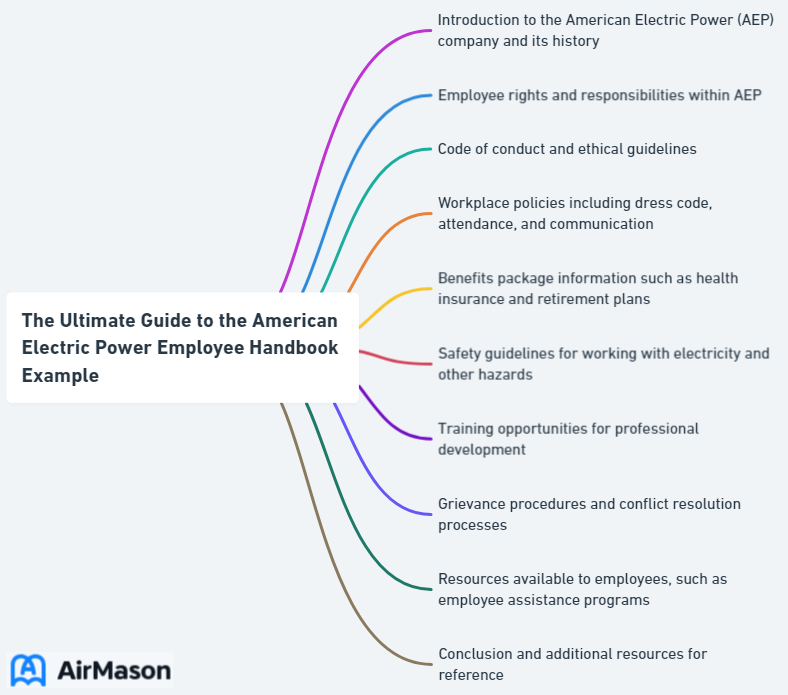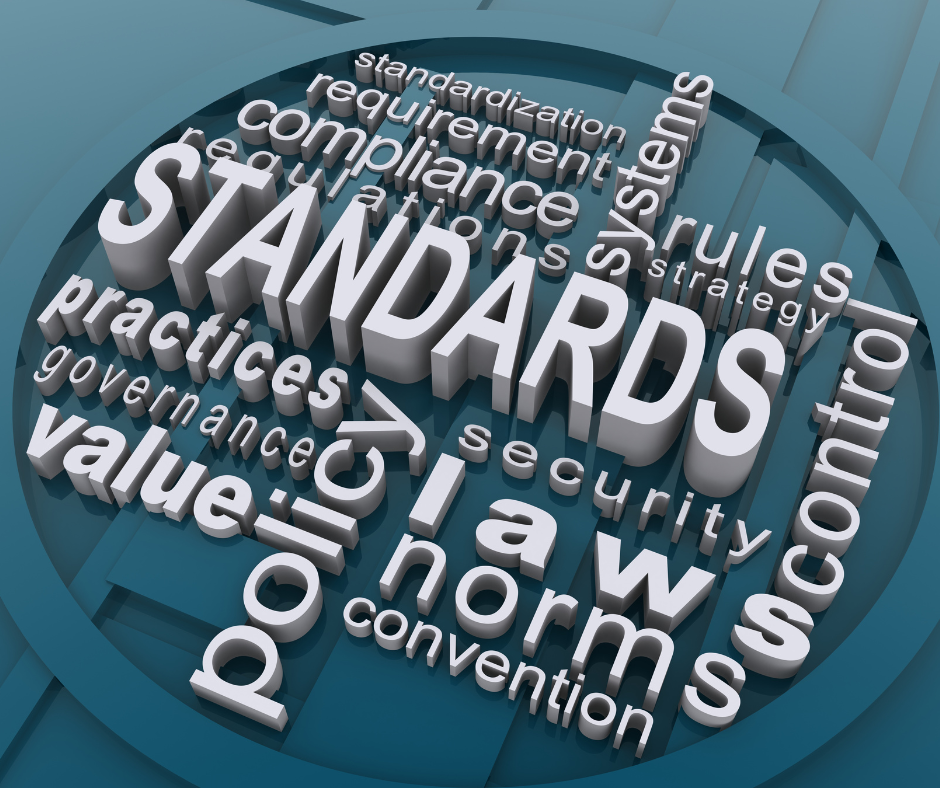
Navigating the complexities of the American Electric Power (AEP) Employee Handbook can be challenging, especially for new employees. This ultimate guide will help you understand the essential components, benefits, and policies outlined in this comprehensive resource, using an “American Electric Power Employee Handbook Example.” By the end of this blog post, you’ll have a clear understanding of the AEP Employee Handbook, its importance, and how it can be tailored to suit the needs of your organization.
Key Takeaways
- The AEP Employee Handbook outlines essential components of employment to ensure employees understand their roles and responsibilities.
- The handbook covers important policies, guidelines, compensation & benefits packages, professional development opportunities and leave policies for a positive workplace environment.
- Separation procedures should be carried out with legal & ethical guidelines to benefit both employer & employee interests.
Fortune 100 Company Employee Handbook
Welcome to our esteemed Fortune 100 company, where excellence is not just a goal but a way of life. The “Fortune 100 Company Employee Handbook” serves as your comprehensive guide to understanding our organizational values, policies, and expectations. Within these pages, you will find essential information about workplace conduct, benefits, and the unique opportunities that come with being part of a globally recognized industry leader. As you embark on your journey with us, refer to this handbook to navigate the principles that define our company culture and contribute to our shared success. We encourage you to familiarize yourself with its contents, ensuring a harmonious and productive experience for both you and your colleagues.
Understanding the American Electric Power Employee Handbook
The American Electric Power Employee Handbook serves as a comprehensive guide, outlining company policies, guidelines, and employee expectations. It covers a wide range of topics, including:
- Conduct and behavior expectations
- Employee benefits
- Environmental and human rights policy adherence
- Industry-specific issues and regulations
The handbook’s page provides employees with valuable information and serves as a reference for understanding the company’s values and expectations.
Adapting the handbook to match the company’s specific needs and culture is highly beneficial as it allows for policy and procedure adjustments. By tailoring the handbook, the company can effectively communicate its expectations to employees, encourage adherence to legal and regulatory requirements, and address the unique challenges and priorities of the organization.
Also, adapting the handbook to include diversity, equity, and inclusion initiatives can foster a positive and inclusive work environment.

Importance of the Handbook
An employee handbook significantly aids in offering clear directives and expectations for employees, ensuring policy uniformity, fostering a productive work culture, and protecting both employer and employee rights. The AEP Employee Handbook serves as a comprehensive guide, elucidating employee rights and outlining company policies and guidelines. This invaluable resource not only provides guidance but also guarantees compliance by delineating rules and regulations pertaining to employees’ conduct and expectations.
The AEP Employee Handbook aims to provide employees with a clear understanding of their responsibilities and expectations, serving as a guide for professional behavior and adherence to legal and ethical mandates. By generating a collective knowledge base within the team, the handbook aids in ensuring everyone is aware of what is relevant and important to their roles.
Customizing the Example
Adapting the AEP Employee Handbook to align with a specific organization’s culture is crucial for ensuring consistency and relevance. Some ways to customize the handbook to fit your organization’s culture include:
- Incorporating the organization’s mission, vision, and values
- Aligning policies and procedures with unique practices and expectations
- Using language and tone that resonate with the employees
Furthermore, it’s important to consider the laws and regulations of different states while customizing the handbook, ensuring compliance with applicable employment laws and avoiding potential liabilities.
Adapting an employee handbook ensures it accurately mirrors the organization’s values, goals, and expectations, fostering a positive workplace environment and promoting employee engagement. By following the steps for customizing an employee handbook, such as:
- Starting with your company’s culture and values
- Constructing policies and rules under each outlined topic
- Personalizing the template to suit your specific needs and branding
You can create a valuable resource tailored to your organization’s unique requirements.
Key Components of the AEP Employee Handbook

This part highlights the key elements of the AEP Employee Handbook, covering employment fundamentals, workplace guidelines, and conduct standards. These components ensure that employees have a clear understanding of their roles and responsibilities, as well as the company’s expectations regarding their conduct and performance.
Employment Essentials

The Employment Essentials section of the AEP Employee Handbook covers important policies and guidelines pertaining to:
- Employment at-will
- Equal employment opportunity
- Anti-discrimination and harassment
- Code of conduct and ethics
- Benefits and compensation
- Leave policies
- Work hours and schedules
- Performance expectations and evaluations
- Health and safety guidelines
- Confidentiality and data protection
- Grievance procedures
These essentials are vital in maintaining a harmonious work environment and ensuring that new employees can efficiently fulfill their roles while adhering to company policies and taking appropriate actions.
Grasping these employment fundamentals allows both employers and employees to clearly understand their rights and duties within the company. This knowledge not only helps prevent potential misunderstandings and conflicts but also fosters a supportive and inclusive work environment where employees feel valued and respected.
Waste Management Employee Handbook Example
In the Waste Management employee handbook example, employees gain valuable insights into company policies, procedures, and expectations. This comprehensive guide outlines the organization’s commitment to waste reduction, safety protocols, and environmental sustainability. The Waste Management employee handbook example serves as a reference for fostering a culture of responsibility and adherence to ethical standards. Covering topics ranging from workplace safety to waste disposal guidelines, this handbook plays a pivotal role in ensuring a cohesive and environmentally conscious workforce. Employees can rely on this resource to navigate their roles effectively while contributing to Waste Management’s commitment to a greener future.
Workplace Guidelines

The AEP Employee Handbook’s workplace guidelines offer a structure for employees to adhere to while carrying out their responsibilities. These guidelines cover various aspects of the work environment, including:
- Work classifications
- Conducting business with integrity before government officials
- Compliance with the Rules of Conduct
- Recognition and appropriate response to workplace aggression
- The value of employee contributions to the workplace
Adherence to these guidelines ensures a safe, productive, and professional work environment for all employees. By understanding and following these guidelines, employees can contribute to the overall success of the company and foster a culture of collaboration and respect.
Also, workplace guidelines act as a reference for supervisors and managers to address employee concerns or conflicts, ensuring equitable and consistent treatment for all employees.
Conduct Standards

Conduct standards are key in defining the expected behavior of AEP employees. These standards encompass non-discrimination, responsible and safe operational management, adherence to legal and ethical standards, and encouragement of an Ethics Program. Employees are expected to act with integrity, respect, and professionalism in their interactions with colleagues, customers, and stakeholders, as well as adhere to the Rules of Conduct provided in the handbook.
By understanding and adhering to the conduct standards outlined in the AEP Employee Handbook, employees can contribute to fostering an inclusive and respectful work environment. These standards include:
- Promoting ethical behavior and compliance with laws and regulations
- Maintaining a positive workplace atmosphere
- Valuing and recognizing employees for their contributions
By following these standards, employees can help create a work environment where everyone feels valued and respected.
Compensation, Benefits, and Professional Development

This part discusses the pay structure, incentives, benefits, and training opportunities provided by AEP. Understanding the company’s approach to compensation and the various benefits available can help employees make more informed decisions about their careers and contribute to their overall satisfaction and well-being.
Pay Structure and Incentives

The pay structure at AEP varies depending on the position, with salaries ranging from approximately $30,000 per annum for production workers to $137,701 per annum for information technology roles. The average salary at AEP is $85,514 per annum. In addition to their base salary, employees may also be eligible for financial bonuses and incentives, depending on the company’s performance, business unit performance, and individual employee performance.
A competitive pay structure and incentives are vital in attracting and keeping the best talent in the workforce. By offering fair compensation and opportunities for financial rewards, AEP demonstrates its commitment to valuing its employees and recognizing their contributions to the company’s success.
Employee Benefits and Perks

AEP offers a comprehensive benefits package to its employees, including:
- Health insurance
- Dental insurance
- Vision insurance
- Life insurance
- Disability insurance
- 401(k) plan
- Work/life programs
These non-monetary benefits play a significant role in employee satisfaction and retention, as they demonstrate the company’s commitment to supporting employees’ overall well-being.
AEP also offers unique benefits to its employees, including bi-annual pay raise opportunities, professional development programs, and educational support. These benefits not only contribute to employees’ financial stability and personal growth but also help create a supportive and inclusive work environment where employees feel valued and motivated to perform at their best.
Training and Development Opportunities

AEP is committed to supporting the professional advancement of its employees through various training and development programs. These programs include:
- Co-op and internship opportunities for students
- Safety training
- Professional development programs
- Pre-apprenticeship training programs for women in linework
- E-learning courses for community leaders to support local economic development
By providing employees with opportunities for further education, skill development, and obtaining certifications for desired positions, AEP demonstrates its dedication to fostering a culture of continuous learning and growth. Investing in employee development not only benefits the individual employees but also contributes to the overall success and competitiveness of the company.
Work Hours, Time Off, and Leave Policies

This part covers the company’s policies on working hours, paid time off, and various types of leave, including parental leave and medical leave. Understanding these policies is essential for employees to strike a healthy work-life balance and ensure they are aware of their rights and entitlements within the company.
Regular Work Hours and Overtime

AEP’s standard working hours may vary depending on the position and department, with some employees reporting 8-hour shifts from 8 am to 5 pm with an hour for lunch. However, it’s important to note that there may be variations in working hours based on specific job roles and responsibilities. Overtime payment at AEP may also vary depending on the specific role and employment agreement. It is advisable to refer to the AEP Employee Handbook or consult with the HR department for detailed information on the company’s work hours and overtime policies.
By following these policies, employees can ensure a balanced work environment and the respect of their rights and entitlements. It is essential for both employers and employees to understand and follow these guidelines to avoid potential conflicts and promote a healthy and productive workplace.
Paid Time Off and Vacation

AEP provides vacation days to its employees, with the amount varying depending on the individual employee. It is typical for employees to start with 2 weeks of paid time off, which can be used for vacation, sick days, or personal time. Understanding the company’s policies on paid time off and vacation is essential for employees to plan their time away from work and maintain a healthy work-life balance.
These policies not only aid employees in their personal lives but also foster a work environment where employees feel valued and motivated. By offering fair and competitive paid time off and vacation policies, AEP demonstrates its commitment to employee well-being and satisfaction.
Family, Medical, and Other Leaves of Absence
AEP offers various types of leave to its employees, such as paid parental leave for births and adoptions, paid maternity leave, and sick leave. These policies support employees during various life events and help maintain a positive work environment. AEP also adheres to the Family and Medical Leave Act (FMLA), a federal law that permits eligible employees to take unpaid leave for specific family and medical reasons while providing job protection and continuation of health benefits during their leave.
By understanding and adhering to the company’s leave policies, employees can ensure they are aware of their rights and entitlements, while also contributing to a supportive and inclusive workplace culture. These policies not only benefit the individual employees but also help create a positive work environment where employees feel valued and cared for.
Employee Separation and Termination Procedures
This part offers direction on the procedures for voluntary resignation, involuntary termination, and exit interviews. Understanding these procedures is essential for employees and employers alike, as they ensure a smooth and respectful transition during employment separation.
Voluntary Resignation
When resigning from AEP, it is recommended to follow the established resignation procedure, which might involve submitting a written resignation notice to the supervisor or filling out a company-provided employee resignation form. Communicating your resignation in writing and providing a notice period, typically two weeks, can help facilitate a smooth transition for both you and the company. Additionally, it is prudent to inquire about any necessary paperwork or exit procedures that need to be completed before your departure.
Following the proper resignation procedure not only ensures a respectful and professional exit from the company but also helps maintain positive relationships with supervisors and colleagues. This can be beneficial for future networking opportunities and professional growth.
Involuntary Termination
Involuntary termination can be a challenging and sensitive process for both employees and employers. While the specific reasons and procedures for involuntary termination at AEP are not readily available in search results, it is essential for employers to follow legal and ethical guidelines when terminating an employee’s employment. This may include:
- Providing a rationale for the termination
- Coordinating with Human Resources
- Adhering to the provisions outlined in the company’s involuntary employment termination policy
By understanding and adhering to legal and ethical guidelines during involuntary termination, employers can ensure a respectful and professional process that minimizes potential conflicts and legal issues. This not only benefits the individual employees but also helps maintain a positive work environment and reputation for the company.
Exit Interviews and Final Paychecks
AEP carries out exit interviews with departing employees, typically face-to-face with a Human Resources representative or the employee’s direct manager. The purpose of the exit interview is to gather feedback and insights from the departing employee in order to improve company performance and ensure a positive experience for the employee. By conducting effective exit interviews, companies can learn from their employees’ experiences and make necessary improvements to their policies, procedures, and work environment.
When it comes to final paychecks for departing employees, AEP adheres to the guidelines outlined by state laws. While federal law does not mandate employers to provide former employees with their final paycheck immediately, state laws may have specific requirements regarding the timing and method of payment. It is essential for employers to be aware of and comply with these laws to avoid potential liabilities and maintain a positive reputation.
Emerson Electric Employee Handbook Example
In the Emerson Electric employee handbook example, employees gain access to a comprehensive guide that outlines the company’s policies, procedures, and expectations. This invaluable resource serves as a roadmap for navigating the workplace, ensuring that every team member is well-informed and aligned with the company’s mission and values. From codes of conduct to benefits information, the Emerson Electric employee handbook example encapsulates the organization’s commitment to fostering a positive and inclusive work environment. With clarity and transparency at its core, this handbook exemplifies Emerson Electric’s dedication to empowering its workforce and promoting a culture of success.
Summary
In conclusion, understanding the American Electric Power Employee Handbook is essential for employees to navigate the complexities of their roles and responsibilities within the company. By familiarizing themselves with the handbook’s various components, employees can ensure they are aware of their rights, entitlements, and obligations, while also contributing to a supportive and inclusive work environment. With a comprehensive understanding of the AEP Employee Handbook, employees can confidently move forward in their careers, knowing they are well-prepared for success.
Frequently Asked Questions
What are the values of American Electric Power?
American Electric Power Co. Inc.’s corporate values of Zero Harm, Integrity & Stewardship, Adapt & Achieve, and Customer Focus all emphasize doing the right thing, emphasizing their commitment to ethical behavior and customer focus.
Is American Electric Power a utility company?
American Electric Power Company, Inc. is an investor-owned electric utility in the United States, delivering electricity to over five million customers in 11 states. Therefore, it is a utility company.
Who owns American Electric Power?
American Electric Power Company Inc (NASDAQ:AEP) is largely owned by institutional investors, who control 75.61% of the outstanding shares, making it one of the most widely held stocks in the Electric Utilities industry.
What is the AEP 401K summary plan?
The AEP 401K summary plan provides a cash balance benefit that grows through an interest credit and an employer company credit percentage based on age and service.
What are the essential components of the AEP Employee Handbook?
The AEP Employee Handbook contains essential components such as employment essentials, workplace guidelines, conduct standards, compensation and benefits, and professional development opportunities to ensure workplace excellence.
Important Disclaimer:
The article presented here does not serve as a representation of the company’s actual employee handbook mentioned in this article.
Our discussions and insights regarding employee handbook are based on assumptions about what may be considered significant in this companies’ policies. These assumptions are drawn from available information and industry knowledge. Readers are advised that the content provided is for informational purposes only and should not be construed as an exact reflection of any company’s official policies or procedures. For precise and accurate details regarding a company’s employee handbook, individuals should refer directly to the company’s official documentation or consult with appropriate representatives.
Please be aware that the content on this page has been generated by using artificial intelligence language models and may contain errors, inconsistencies, or outdated information. It is provided as-is without any warranties or guarantees of accuracy. We strongly recommend using this content as a starting point for further research. We disclaim any liability for damages or losses resulting from the use or reliance on this content.